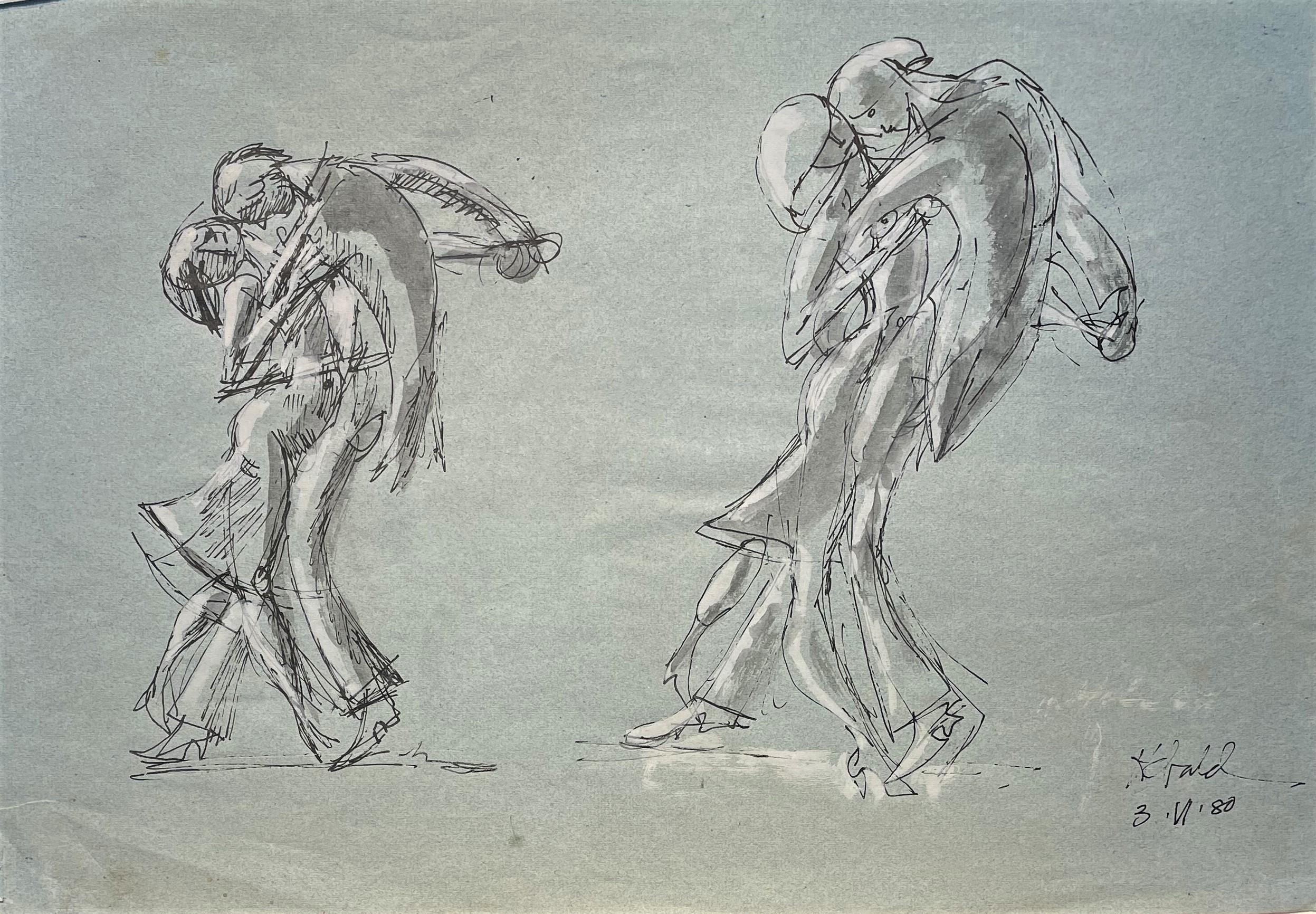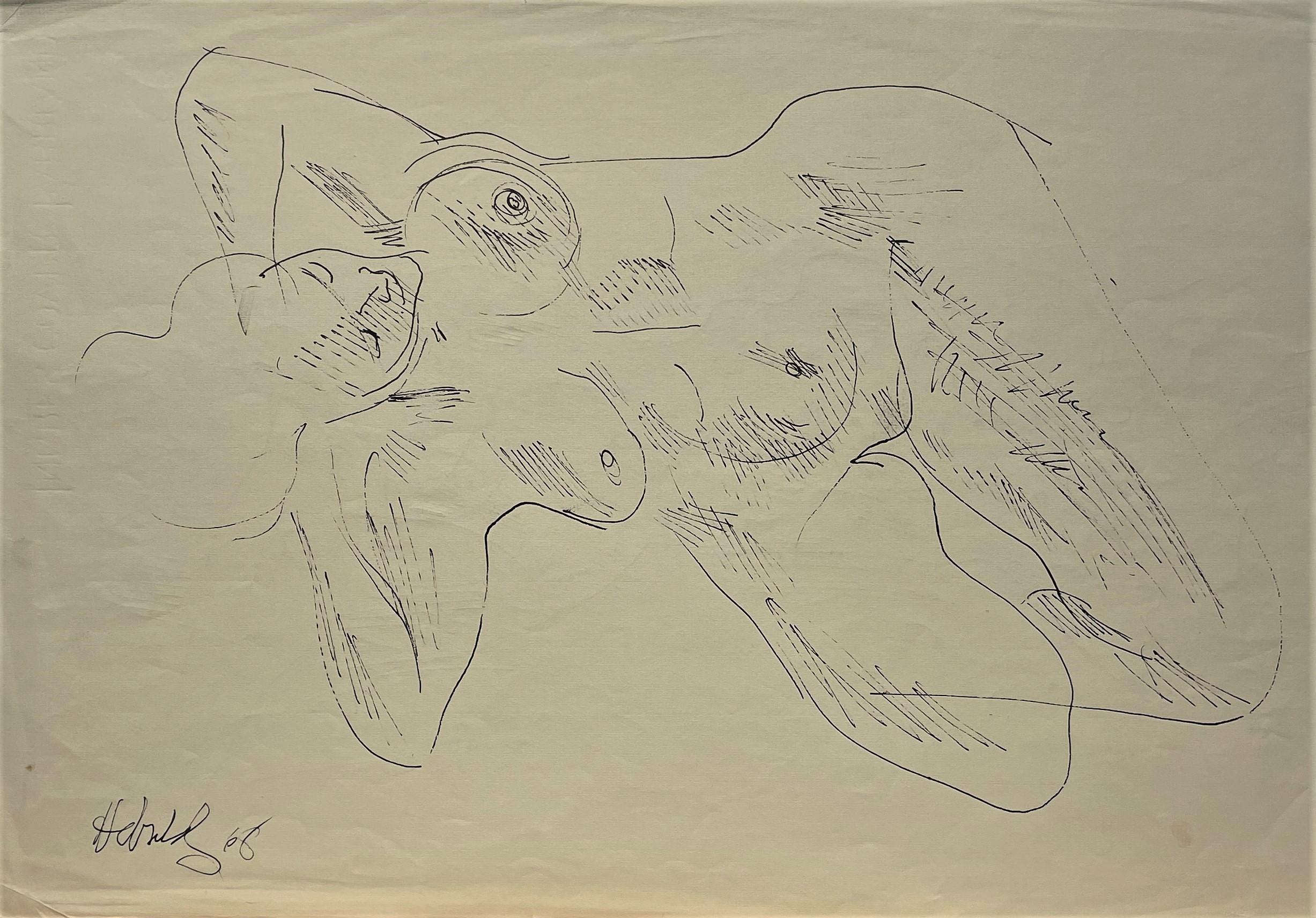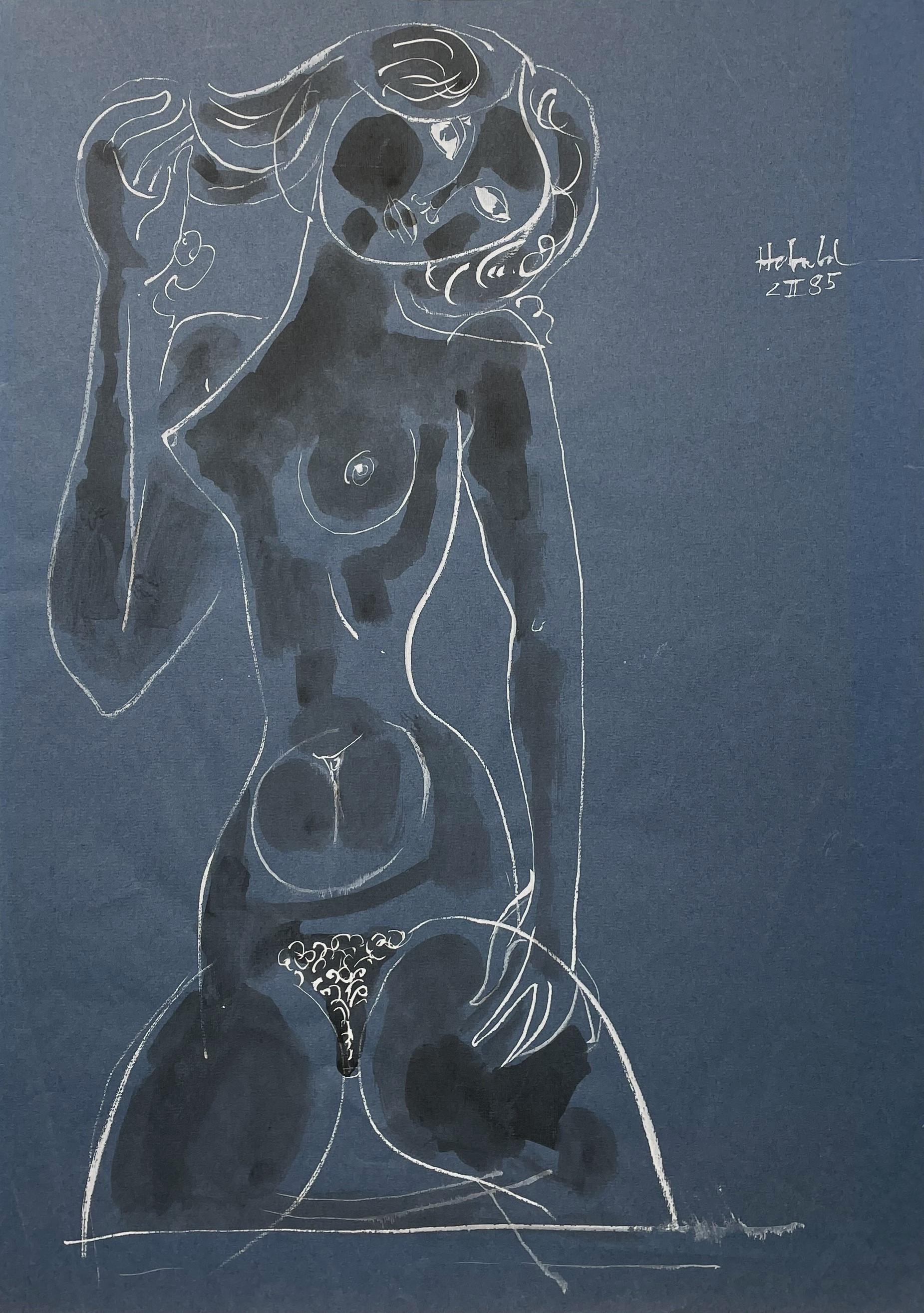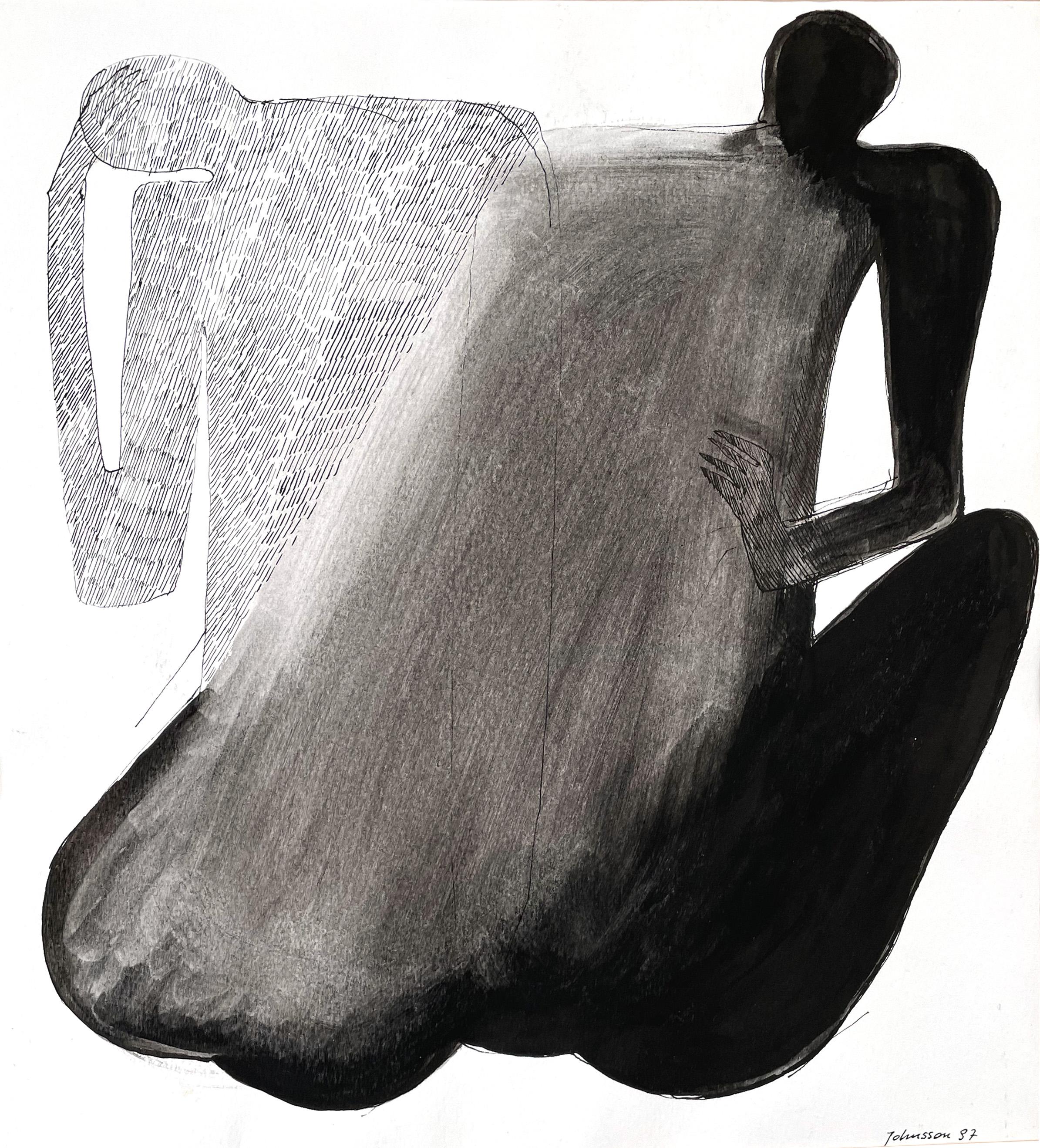Items Similar to Mid Century Modern British 'Listeners' by British German illustrator Kapp, 1959
Want more images or videos?
Request additional images or videos from the seller
1 of 8
Edmond Xavier KappMid Century Modern British 'Listeners' by British German illustrator Kapp, 19591959
1959
About the Item
Edmond Xavier Kapp (British, 1890 – 1978)
Listeners
Inkpen
Signed, inscribed and date ‘Listeners / Kapp 59’ (lower left)
7.5/8 x 10.1/2 in. (19.4 x 26.7 cm.)
Edmond Kapp was born in Islington, London, on 5 November 1890, of American and German Jewish parentage. He gave himself the middle initial ‘X’ – sometimes said to stand for Xavier – to distinguish himself from his father Emil Kapp, who was a wine merchant. However, his parents called him ‘Eddie’ while his wife and friends knew him as ‘Peter’.
During his early years, Kapp was continually ill and, while convalescing, entertained himself by drawing at home. As his health improved, he attended Dame Alice Owen’s School, Islington (1903-10), with periods at Berlin University (1909) and L’Institut Français pour les Etrangers, Paris (1909). He then read Languages at Christ’s College, Cambridge (1910-13), though spent most of his time writing and drawing.
Kapp took a studio in London, and worked intensively until the outbreak of the First World War, contributing to the Daily News, the Onlooker and other periodicals. During the war, he served as a 2nd Lieutenant in the Royal Sussex Regiment on the Western Front, and then in Intelligence, rising to the position of Staff Captain on Haig’s Staff. Finally, he founded and directed the Neutral Press Counter-propaganda Section.
In 1919, Kapp returned to London and, after abortive periods at three art schools, worked alone. In that year, he made his name with an exhibition of caricatures, held at Furst’s Gallery, London, and accompanied by a catalogue introduced by Max Beerbohm. This soon led to contracts with three London periodicals and a book of caricatures, Personalities, published by Martin Secker. Through the 1920s and 30s, his drawings of musicians and other personalities appeared in a wide variety of periodicals, most notably Time & Tide; were collected in further volumes; and were exhibited at the Leicester Galleries. He considered himself to be a ‘character-portraitist’, producing images of psychological not satirical power, and disliking the term ‘caricature’.
Between the wars, Kapp developed other aspects of his artistic talents, the desire to study and the search for subject matter often taking him abroad. For instance, work at the British Academy, Rome, under Antonio Sciortino, and with the American painter, Maurice Sterne, led him to produce his first oils (1923); while an introduction to the League of Nations in Geneva allowed him to use his new-found skill in lithography to produce portraits of twenty-five of its members (1933-35). This expansive and exploratory attitude to his work resulted in an increase in patrons and exhibitions, and in important artistic friendships, notably with Picasso (Picasso sat for Kapp in 1938).
Kapp worked as an Official War Artist during the Second World War, and then as an Official Artist to UNESCO. In the post-war period, he had a studio in Beausoleil, Alpes Maritimes, and explored abstract painting ‘passionately, though without dogmatism’ (Edmond Kapp, London: Whitechapel Art Gallery, 1961, page 8).
Kapp died on 29 October 1978. His sister – the artist Helen Kapp – had died earlier in the same month. The first of his three wives was Yvonne Kapp, biographer of Eleanor Marx and author of the memoir, Time Will Tell. They had visited Beerbohm in Rapallo during their honeymoon in 1923.
His work is represented in numerous public collections, including the National Portrait Gallery; The Barber Institute of Fine Arts (University of Birmingham), the Fitzwilliam Museum (Cambridge) and Manchester Art Gallery; and Albright-Knox Art Gallery (Buffalo).
- Creator:Edmond Xavier Kapp (1890 - 1978, British)
- Creation Year:1959
- Dimensions:Height: 7.63 in (19.39 cm)Width: 10.5 in (26.67 cm)Depth: 1 in (2.54 cm)
- Medium:
- Movement & Style:
- Period:
- Condition:Minor creases to edges, laid on card with artist’s red penline, in a fresh white mount, behind glass in a wood frame with knocks and abrasions. Overall in good order.
- Gallery Location:Petworth, GB
- Reference Number:1stDibs: LU540313641002
About the Seller
4.9
Platinum Seller
These expertly vetted sellers are 1stDibs' most experienced sellers and are rated highest by our customers.
Established in 2010
1stDibs seller since 2017
226 sales on 1stDibs
Typical response time: 2 hours
- ShippingRetrieving quote...Ships From: Petworth, United Kingdom
- Return PolicyA return for this item may be initiated within 10 days of delivery.
More From This SellerView All
- Mid Century Modern British 'Hot Soup' by British German illustrator Kapp, 1938Located in Petworth, West SussexEduard Xavier Kapp (British, 1890 – 1978) Hot soup Pen on paper Inscribed and dated ‘Hot Soup / 15-12-38’ (upper right) and signed ‘kapp’ (lower right) 7.1/2 x 12.3/8 in. (19 x 31.5 cm.) Edmond Kapp was born in Islington, London, on 5 November 1890, of American and German Jewish parentage. He gave himself the middle initial ‘X’ – sometimes said to stand for Xavier – to distinguish himself from his father Emil Kapp, who was a wine merchant. However, his parents called him ‘Eddie’ while his wife and friends knew him as ‘Peter’. During his early years, Kapp was continually ill and, while convalescing, entertained himself by drawing at home. As his health improved, he attended Dame Alice Owen’s School, Islington (1903-10), with periods at Berlin University (1909) and L’Institut Français pour les Etrangers, Paris (1909). He then read Languages at Christ’s College, Cambridge (1910-13), though spent most of his time writing and drawing. Kapp took a studio in London, and worked intensively until the outbreak of the First World War, contributing to the Daily News, the Onlooker and other periodicals. During the war, he served as a 2nd Lieutenant in the Royal Sussex Regiment on the Western Front, and then in Intelligence, rising to the position of Staff Captain on Haig’s Staff. Finally, he founded and directed the Neutral Press Counter-propaganda Section. In 1919, Kapp returned to London and, after abortive periods at three art schools, worked alone. In that year, he made his name with an exhibition of caricatures, held at Furst’s Gallery, London, and accompanied by a catalogue introduced by Max Beerbohm. This soon led to contracts with three London periodicals and a book of caricatures, Personalities, published by Martin Secker. Through the 1920s and 30s, his drawings of musicians and other personalities appeared in a wide variety of periodicals, most notably Time & Tide; were collected in further volumes; and were exhibited at the Leicester Galleries. He considered himself to be a ‘character-portraitist’, producing images of psychological not satirical power, and disliking the term ‘caricature’. Between the wars, Kapp developed other aspects of his artistic talents, the desire to study and the search for subject matter often taking him abroad. For instance, work at the British Academy, Rome, under Antonio Sciortino...Category
Mid-20th Century Modern Figurative Drawings and Watercolors
MaterialsInk, Paper
- Mid Century St. Ives artist Sven Berlin 'A lover's embrace' pen and ink on paperLocated in Petworth, West SussexSven Berlin (British, 1911 - 1999) A Lovers embrace Pen and ink Signed 'SVEN 95' (lower right) 11 x 7.7/8 in. (20 x 28 cm.) Sven Berlin, born in Sydenham, London on 14th September 1...Category
20th Century Modern Figurative Drawings and Watercolors
MaterialsPaper, Ink, Pen
- British, early 20th Century oriental scene by female artist Katie BlackmoreLocated in Petworth, West SussexKatie Blackmore (British, 1890 – 1957) Oriental fantasy Ink and gouache on paper Signed ‘K Blackmore’ (lower right) 9 x 8.3/8in. (22.8 x 21.2 cm.) A Scottish figurative and decorative artist, Katie Blackmore was closely associated with both Jessie Marion King...Category
20th Century Academic Figurative Drawings and Watercolors
MaterialsPaper, Ink, Gouache
- Jean Dupas art deco drawing, 'The Angel of light'By Jean DupasLocated in Petworth, West SussexJean Dupas (French, 1882 – 1964) The angel of light Pen and ink and charcoal on paper 14.3/4 x 12.1/2 in. (37.5 x 31.8 cm.) One of the leading artists of the Art Deco period, Jean Théodore Dupas was the son of a merchant marine captain and began his adult life as a merchant seaman. Poor health meant that he had to abandon this career and he enrolled in art school instead, first in his native Bordeaux and later in Paris. He won the Prix de Rome in the category of painting in 1910 and studied at the Académie de France in Rome, from where he sent several paintings to the Paris Salons, although his studies were interrupted by the outbreak of war. Dupas’s work came to public prominence on the occasion of the seminal Exposition des Arts Décoratifs in Paris in 1925. He was chosen by the furniture designer Jacques-Emile Ruhlmann to provide paintings for the latter’s Maison d’un collectionneur, alongside furniture by Ruhlmann and objects by many of the leading Art Deco craftsmen of the day, while other paintings by Dupas were also displayed to great effect elsewhere in the Exposition. In the late 1920’s and 1930’s Dupas won a number of important and prestigious commissions. In 1926 he worked alongside Ruhlmann and the sculptor Alfred Jeanniot on the decoration of the tearoom of the ocean liner Ile-de-France; the first of the grand transatlantic ships to be built in France after the First World War. By this time Dupas had firmly established his reputation. Writing in 1927, his fellow artist George Barbier could already note that ‘Few artists have at such an early age attained such a degree of success, or gathered around them such swarms of imitators and disciples.’ Dupas reached the height of his fame in the mid 1930’s, and in 1934 he received his most important commission to date; a series of large glass murals...Category
Early 20th Century Art Deco Figurative Drawings and Watercolors
MaterialsPaper, Crayon, Ink, Pen
- 19th Century drawing attributed to John Flaxman of a classical maidenBy John FlaxmanLocated in Petworth, West SussexAttributed to John Flaxman (British, 1755- 1826) Study of a classical maiden Pen and ink on paper 5.1/2 x 3.1/8 in. (14 x 8 cm.)Category
19th Century Academic Figurative Drawings and Watercolors
MaterialsPaper, Ink, Pen
- William Heath Robinson original drawing, British early 20th CenturyBy William Heath RobinsonLocated in Petworth, West SussexWilliam Heath Robinson (British, 1872 - 1944) 'Boring The First Tunnel With An Early Type Of Rotary Excavator, And The Red Flag', circa 1935 (railway ribaldry was published in this year) The former signed 'W. Heath Robinson (lower left) and inscribed with title (lower left and right) The former to mount 14 X 10.1/4in. (35.5 X 26cm.) The latter 1.1/2 X 8.1/2in. (3.8 X 21.6 cm.) Literature: Railway Ribaldry, first published by the Great Western Railway, Paddington, 1935. William Heath Robinson was an English cartoonist and illustrator best known for drawings of ridiculously complicated machines for achieving simple objectives. During the First World War, he drew large numbers of cartoons, depicting ever-more unlikely secret weapons being used by the combatants. In the UK the term "Heath Robinson" entered popular language during this time as a description of any unnecessarily complex and implausible contrivance. Its continuing popularity was undoubtedly linked to Second World War Britain's shortages and the need to "make do and mend". In the course of his work, Robinson also wrote and illustrated three childrens books including The Adventures of Uncle Lubin (1902) which is regarded as the genesis of his depiction of unlikely machines. The inventions he drew were frequently powered by steam boilers or kettles, heated by candles or a spirit lamp and usually kept running by balding, bespectacled men in overalls. There would be complex pulley arrangements, threaded by lengths of knotted string. One of his most famous series of illustrations accompanied the first Professor Branestawm book written by Norman Hunter. The stories provided a perfect backdrop for Robinson's drawings. One of the automatic analysis machines built for Bletchley Park during the Second World War to assist in the decryption of German message traffic was named "Heath Robinson" in his honour. He died in September 1944 during the Second World War and is buried in East Finchley Cemetery. The Heath Robinson Museum in Pinner opened in October 2016 to house a collection of nearly 1,000 original artworks owned by The William Heath Robinson Trust. In the Wallace and Gromit...Category
20th Century Figurative Drawings and Watercolors
MaterialsPaper, Ink, Pen
You May Also Like
- Lindy Hop StudyLocated in Santa Fe, NMA wonderful pen and ink study of entwined dancers by Milton Hebald, beautifully executed on a lovely grey Italian rag paper. Hebald is regarded as one of the most important American figurative...Category
Late 20th Century American Modern Figurative Drawings and Watercolors
MaterialsPaper, Ink, Tempera
- Dancers StudyLocated in Santa Fe, NMA wonderful pen and ink study of entwined dancers by Milton Hebald, beautifully executed on a lovely grey Italian rag paper. Hebald is regarded as one of the most important American figurative...Category
Late 20th Century American Modern Figurative Drawings and Watercolors
MaterialsPaper, Ink, Tempera
- AntonellaLocated in Santa Fe, NMA rare Ink on Paper nude figure drawing by Milton Hebald. It is especially unique as both side of the paper have fully resolved drawings of the same subject, 'Antonella'. Hebald is regarded as one of the most important American figurative sculptors...Category
Late 20th Century American Modern Nude Drawings and Watercolors
MaterialsPaper, Ink
- Nude GirlLocated in Santa Fe, NMA rare Ink on Paper nude figure drawing by Milton Hebald, beautifully executed on a lovely blue Italian rag paper. Given the stylization, it is likely a study for one of his sculptures. Hebald is regarded as one of the most important American figurative sculptors...Category
Late 20th Century American Modern Nude Drawings and Watercolors
MaterialsInk, Tempera, Paper
- Two in OneBy Jolanta JohnssonLocated in Boxholm, SEJolanta Johnsson, experienced Polish artist, graduate of the Academy of Fine Arts in Warsaw, PhD of fine arts, university teacher. She currently lives in Sweden. This is how she writ...Category
21st Century and Contemporary Modern Figurative Drawings and Watercolors
MaterialsInk, Paper
- School 1994, paper, ink, 15.2x19 cmLocated in Riga, LVSchool 1994, paper, ink, 15,2x19 cm Illustrated in the magazine "School and Family" in 1994.Category
1990s Modern Figurative Drawings and Watercolors
MaterialsPaper, Ink
Recently Viewed
View AllMore Ways To Browse
19th C French Watercolor
Nino Devdariani
John Lennon Watercolor
Alphonse Neuville
Saint Sernin
David Fernandez
Dutch Painter Israels
Monumental French And Italian Mirrors
Original Art Broker
Woodland Stream
Devil Engraving
Louis Rosenthal
Chicks Farm Animals
W Amion
Last Two Weeks Search
Miniature Portraits Women
Womens Waltham
Small Postal Scale





